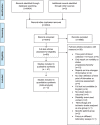Prognostic Hemostasis Biomarkers in Acute Ischemic Stroke
- PMID: 30700129
- PMCID: PMC6392207
- DOI: 10.1161/ATVBAHA.118.312102
Prognostic Hemostasis Biomarkers in Acute Ischemic Stroke
Abstract
Objectives- The prediction of patients at risk for poor clinical outcome after acute ischemic stroke remains challenging. An imbalance of coagulation factors may play an important role in progression and prognosis of these patients. In this systematic review, we assessed the current literature on hemostasis biomarkers and the association with poor clinical outcome in acute ischemic stroke. Approach and Results- A systematic search of Embase, Medline, Cochrane Library, Web of Science, and Google Scholar was performed on studies reporting on hemostasis biomarkers and clinical outcome after acute ischemic stroke. Studies were considered eligible if blood samples were collected within 72 hours after symptom onset. Additionally, clinical outcome should be assessed using a disability score (Barthel Index or modified Rankin scale). Methodological quality of included studies was assessed with an adapted version of the Quality Assessment of Diagnostic Accuracy Studies questionnaire. A total of 80 articles were read full text, and 41 studies were considered eligible for inclusion, reporting on 37 different hemostasis biomarkers. No single biomarker appeared to be effective in predicting poor clinical outcome in acute ischemic stroke patients. Conclusions- Based on current literature, no clear recommendations can be provided on which hemostasis biomarkers are a predictor of clinical outcome after acute ischemic stroke. However, some biomarkers show promising results and need to be further investigated and validated in large populations with clear defined study designs.
Keywords: biomarkers; brain ischemic; hemostasis; prognosis; systematic review.
Figures
Similar articles
-
Renal Function Affects Prognostic Role of Antiphosphatidylserine Antibodies for Acute Ischemic Stroke Patients.Cerebrovasc Dis. 2019;48(1-2):1-8. doi: 10.1159/000501957. Epub 2019 Sep 12. Cerebrovasc Dis. 2019. PMID: 31514186
-
Trial design and reporting standards for intra-arterial cerebral thrombolysis for acute ischemic stroke.Stroke. 2003 Aug;34(8):e109-37. doi: 10.1161/01.STR.0000082721.62796.09. Epub 2003 Jul 17. Stroke. 2003. PMID: 12869717
-
Copeptin as a biomarker for prediction of prognosis of acute ischemic stroke and transient ischemic attack: a meta-analysis.Hypertens Res. 2017 May;40(5):465-471. doi: 10.1038/hr.2016.165. Epub 2016 Dec 1. Hypertens Res. 2017. PMID: 27904159 Review.
-
Antiphosphatidylserine Antibodies and Clinical Outcomes in Patients With Acute Ischemic Stroke.Stroke. 2016 Nov;47(11):2742-2748. doi: 10.1161/STROKEAHA.116.013827. Epub 2016 Oct 11. Stroke. 2016. PMID: 27729578
-
Blood Biomarkers for the Differentiation of Cardiac Ischemic Stroke Subtypes: A Systematic Review.Cardiovasc Hematol Disord Drug Targets. 2019;19(3):215-227. doi: 10.2174/1871529X18666180829142354. Cardiovasc Hematol Disord Drug Targets. 2019. PMID: 30160220
Cited by
-
Ischemic Stroke among the Symptoms Caused by the COVID-19 Infection.J Clin Med. 2020 Aug 19;9(9):2688. doi: 10.3390/jcm9092688. J Clin Med. 2020. PMID: 32825182 Free PMC article. Review.
-
Low α2-Plasmin Inhibitor Antigen Levels on Admission Are Associated With More Severe Stroke and Unfavorable Outcomes in Acute Ischemic Stroke Patients Treated With Intravenous Thrombolysis.Front Cardiovasc Med. 2022 Jul 15;9:901286. doi: 10.3389/fcvm.2022.901286. eCollection 2022. Front Cardiovasc Med. 2022. PMID: 35911531 Free PMC article.
-
von Willebrand factor/ADAMTS13 ratio at presentation of acute ischemic brain injury is predictive of outcome.Blood Adv. 2020 Jan 28;4(2):398-407. doi: 10.1182/bloodadvances.2019000979. Blood Adv. 2020. PMID: 31990334 Free PMC article.
-
The burden of suspected strokes in uMgungundlovu - Can biomarkers aid prognostication?Health SA. 2023 May 9;28:1916. doi: 10.4102/hsag.v28i0.1916. eCollection 2023. Health SA. 2023. PMID: 37292236 Free PMC article.
-
PAI-1 5G/5G genotype is an independent risk of intracranial hemorrhage in post-lysis stroke patients.Ann Clin Transl Neurol. 2019 Nov;6(11):2240-2250. doi: 10.1002/acn3.50923. Epub 2019 Oct 21. Ann Clin Transl Neurol. 2019. PMID: 31637872 Free PMC article.
References
-
- Folsom AR, Rosamond WD, Shahar E, Cooper LS, Aleksic N, Nieto FJ, Rasmussen ML, Wu KK. Prospective study of markers of hemostatic function with risk of ischemic stroke. The Atherosclerosis Risk in Communities (ARIC) Study Investigators. Circulation. 1999;100:736–742. - PubMed
-
- Sonneveld MA, de Maat MP, Portegies ML, Kavousi M, Hofman A, Turecek PL, Rottensteiner H, Scheiflinger F, Koudstaal PJ, Ikram MA, Leebeek FW. Low ADAMTS13 activity is associated with an increased risk of ischemic stroke. Blood. 2015;126:2739–2746. doi: 10.1182/blood-2015-05-643338. - PubMed
-
- van Schie MC, DE Maat MP, Dippel DW, de Groot PG, Lenting PJ, Leebeek FW, Hollestelle MJ. von Willebrand factor propeptide and the occurrence of a first ischemic stroke. J Thromb Haemost. 2010;8:1424–1426. doi: 10.1111/j.1538-7836.2010.03863.x. - PubMed
-
- Tzoulaki I, Murray GD, Lee AJ, Rumley A, Lowe GD, Fowkes FG. Relative value of inflammatory, hemostatic, and rheological factors for incident myocardial infarction and stroke: the Edinburgh Artery Study. Circulation. 2007;115:2119–2127. doi: 10.1161/CIRCULATIONAHA.106.635029. - PubMed
Publication types
MeSH terms
Substances
LinkOut - more resources
Full Text Sources


